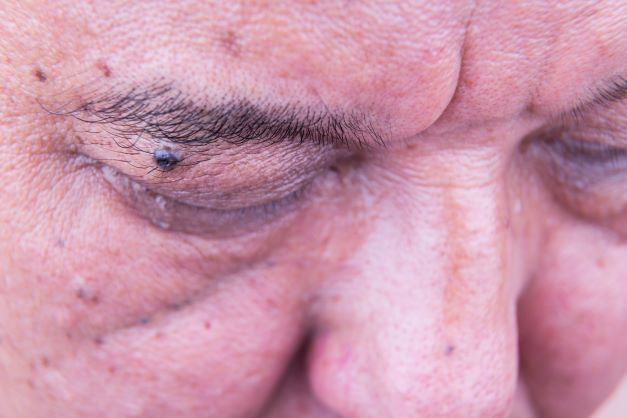Skin cancer is a serious health risk, and while many forms of skin cancer are very noticeable, there are some areas where skin cancer can be harder to detect. Skin cancer on the eyelid is one of those more difficult to diagnose forms of skin cancer because it may go undetected until it reaches the later stages. According to Dr. Ardeshir Edward Nadimi of U.S. Dermatology Partners in Centreville, Virginia, “Skin cancers that occur in harder-to-see places like the eyelids, scalp, nail beds, and bottoms of feet are more likely to go unnoticed. We do our best to remind patients that skin cancers can develop on any part of the body, so it’s important to take special care when performing intermittent skin self-exams. Skin cancer on the lower and upper eyelid and the skin around the eyes can be difficult to see and it may grow slowly over a long period of time, going relatively unnoticed until a symptom such as eye irritation, pain, drainage, or bleeding occurs. That means it’s essential to know what you’re looking for and to check your eyelids regularly for warning signs.” In this blog, Dr. Nadimi will explain more about what skin cancer on the eyelid looks like, how it’s treated, and what steps you can take to prevent eyelid skin cancers.
What Type of Skin Cancer Develops on the Eyelid?
Dr. Nadimi says, “The majority of skin cancers that develop on the eyelid and around the eyes are basal cell carcinomas (BCCs), followed by squamous cell carcinomas (SCCs). Melanoma can occur on the eyelid, in addition to a few much less common cancers.”
What Are the Warning Signs of Skin Cancer on the Eyelid?
During monthly skin self-exams, patients should look for the following warning signs that are often indicative of eyelid skin cancer:
- A growth, bump, spot, or lesion on the eyelid or the skin around the eyes that may grow very slowly and may be a variety of colors (skin-colored, brown, pink, shiny)
- Recurrent ‘stye’ or ‘chalazion’ that doesn’t resolve with treatment by a physician
- Unexplained loss of eyelashes or eyebrows
- Wounds on the eyelid or skin around the eyes that don’t heal or heal very slowly
- Infection of the eyelid or skin around the eyes that doesn’t clear up
- Inflammation, swelling, or thickening of the skin on the eyelid and around the eyes
- Pain or tenderness of the eyelid or skin around the eyes
On the warning signs and symptoms of eyelid skin cancer, Dr. Nadimi says, “It’s important to know what to look for when you’re examining the eyelids for signs of skin cancer because diagnosing eyelid skin cancer earlier means we can provide more effective and conservative treatment solutions. In addition to the specific warning signs of eyelid skin cancer reviewed in this blog, you should watch out for the typical warning signs that we call the ABCDEs of skin cancer. That stands for asymmetry, border, color, diameter, and evolution. Asymmetry means a spot that is different on one side than another. Border means any kind of irregularity around the outside of the lesion. Color could mean a spot that is a different color from other spots on the skin or that has multiple colors within one lesion. Diameter is important because the larger the cancerous lesion the more likely it is to invade nearby tissue and possibly spread to other parts of the body. Finally, evolution is a spot that is changing over time, which is more likely to be cancerous. Ultimately, having a trained dermatologist examine your skin is the best step if you have a suspicious, growing, or non-healing growth on your eyelid.”
What Are the Treatment Options for Eyelid Skin Cancer?
When it comes to treating skin cancer of the eyelid, Dr. Nadimi says, “Mohs micrographic surgery to remove the eyelid tumor is usually our best treatment option. This is a conservative form of surgical removal for cancerous lesions. We excise the cancerous lesion and a very small amount of healthy tissue. Then, we check for any cancer cells in the surrounding tissues. This process is continued until there are no cancerous cells present. For more advanced cases, we may partner with oculoplastic surgeons to assist with the surgical repair, and oncologists to create a comprehensive treatment and follow-up plan.”
Can Eyelid Skin Cancer be Prevented?
According to Dr. Nadimi, “As is the case with other forms of skin cancer, the main cause of eyelid skin cancer is exposure to the sun’s UVA and UVB rays. This means that regular and prolonged sun exposure, frequent sunburns, and having a lighter skin tone all mean an increased risk for skin cancer on the eyelids. Protecting the eyes from UVA and UVB exposure is essential to prevent the development of skin cancer around the eyes.” Limiting or reducing your time in the sun is a great first step, and when you will be receiving sun exposure, you should apply sunscreen to the area around the eyes. Because the skin around the eyes is sensitive, you’ll need to choose sunblock that is specifically formulated for use in this area — mineral/physical sunscreens that contain only zinc or titanium are good choices. Additionally, wearing hats, sunglasses, ski goggles, and other protective gear can help to limit potentially damaging sun exposure. If you work with chemicals, pollutants, allergens, and other environmental irritants, be sure to wear protective goggles to ensure these materials do not damage the skin around the eyes.
In addition to taking steps to prevent any unnecessary exposure to UVA and UVB rays and damaging environmental irritants, you should also perform regular skin cancer self-exams (at least once a month or every other month) to look for the warning signs of skin cancer on the eyelid or any other parts of the body. According to Dr. Nadimi, “Your regular self-exam should be thorough. In a place with good lighting, carefully examine your whole body looking for new or changing lesions on the skin. It is sometimes helpful to have a partner examine areas you can’t see easily and to take pictures on your cell phone to monitor any suspicious spots. Don’t forget the harder-to-see areas like the eyelids, scalp, nail beds, palms of hands, and soles of feet.”
Ready to Talk to a Professional at U.S. Dermatology Partners?
If you’ve noticed something concerning during a skin self-exam, or you have any questions about skin health or available dermatologic services, the skilled professionals at U.S. Dermatology Partners are here to help. You can get started working with one of our practices in your area by completing our online scheduling request form. Once we receive your information, a team member will be in touch to answer any questions and finalize the details of your visit
Find a location near me
or


